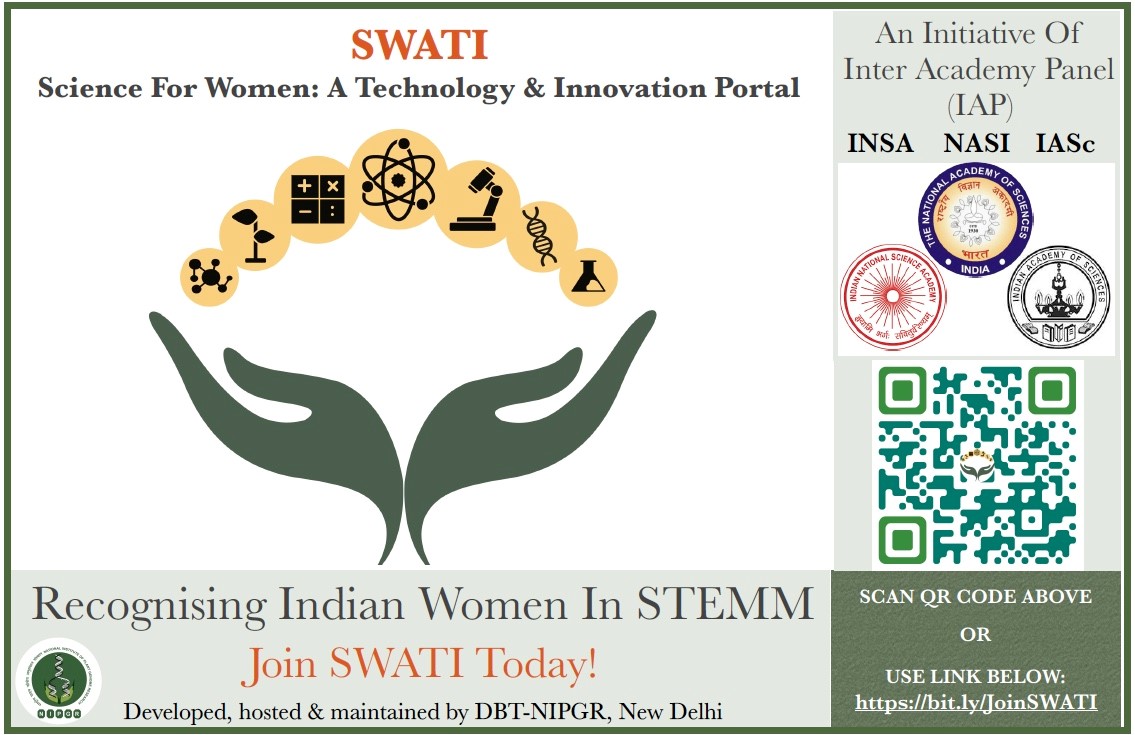Description

Disclaimer: Copyright infringement not intended.
Context
The Principal Scientific Advisor to the Government of India has recently launched the "Science for Women-A Technology & Innovation (SWATI)" Portal, a groundbreaking initiative aimed at advancing the representation of Indian women and girls in STEMM (Science, Technology, Engineering, Mathematics & Medicine) fields.
Details
About SWATI Portal
- Purpose: The portal serves as a single online platform to represent and showcase the contributions of Indian women and girls in STEMM fields.
- Database: It houses a comprehensive database that will aid policymakers in addressing the challenges of gender gap in STEMM fields.
- Interactive Features: SWATI Portal is designed to be interactive, allowing users to access and contribute to the database easily.
- Development: The portal is the first-of-its-kind in India and has been developed, hosted, and maintained by the National Institute of Plant Genome Research (NIPGR) located in New Delhi.
Objectives:
- Exponential Scaling: The primary objective of SWATI Portal is to scale up efforts to include every Indian woman in science, spanning all career stages and subjects, both in academia and industry.
- Research Support: By compiling a comprehensive database, the portal aims to support reliable and statistically significant long-term research on issues related to equality, diversity, and inclusivity in India.
- Active Search Engine: The development of an active search engine and searchable database enables easy access to information about women scientists, their affiliations, areas of interest, and achievements.
Sections in the Portal:
- Icons and Awardees: This section highlights notable women in science, including recipients of prestigious awards such as Padma awards, Shanti Swarup Bhatnagar awards, and Stree Shakti Science Samman.
- Directors, Secretaries, and Academy Presidents: Profiles of women holding leadership positions in various academic and scientific institutions, ministries, and academies are featured here.
- Faculty: The portal includes information about women faculty members in Indian universities and autonomous organizations, covering a wide range of disciplines and research areas.
- Government Organizations: Profiles of women scientists and researchers affiliated with government bodies such as the Ministry of Science and Technology, CSIR, DBT, DST, MHRD, UGC, GATI, and KIRAN are included in this section.

Women in STEM in India
Current Status in India:
- The COVID-19 pandemic exacerbated existing challenges, leading to a decline in the participation of women in the Indian workforce.
- According to a report by The Wire, women accounted for only 19.4% of India's labor force in 2021-22, down from 29.8% in the previous fiscal year.
- This disparity is particularly pronounced in STEM fields, where women are chronically underrepresented. In 2021-22, women constituted only 28% of graduates in engineering and 40% in computer science and informatics.
- Females generally receive fewer research grants as compared to their male counterparts. Although 33 percent of researchers are women, only 12 percent are members of national science academics.
- In the artificial intelligence industry, only one out of five professionals are female.
- According to the All India Survey on Higher Education (AISHE), women constituted 43% of STEM graduates in 2019-20, surpassing several developed countries. However, female representation in STEM professions remains low at 14%, highlighting the need for sustained efforts to address institutional gender discrimination, rigid gender roles, and patriarchal attitudes.
- Surprisingly, about 43 percent of STEM graduates in India are women, outdoing developed countries like Canada, the United States, and the UK, where women graduates constitute 31 percent, 34 percent, and 38 percent respectively.
- According to the yearly report of the All India Survey on Higher Education (AISHE), which tracks enrolment in undergraduate, master’s, and PhD courses, women choosing STEM courses in India have increased to 10,56,095 in 2019-20 from 10,02,707 in 2017-18.
- Furthermore, the Scorpus database revealed that one in three research papers is authored by women across 186 fields and that there is no difference in male and female competency when it comes down to subjects like psychology, dentistry, and humanities – domains where male authors outnumber their female counterparts by two to one. Despite this, women’s representation in STEM presently stands at an abysmal 14 percent.
Reasons for Underrepresentation:
- Societal Expectations: Deep-rooted societal beliefs often discourage girls from pursuing careers in STEM, emphasizing marriage and family over professional aspirations.
- Gender Stereotypes: Negative stereotypes about women's abilities in STEM perpetuate the misconception that these fields are better suited for men.
- Educational Opportunities: Limited access to quality education and resources, especially in rural areas, hinders women's participation in STEM.
- Workplace Discrimination: Gender bias and discrimination in the workplace create barriers to career advancement and leadership opportunities for women in STEM.
- Lack of Role Models: The absence of visible female role models and mentors in STEM fields diminishes opportunities for aspiring women to envision themselves in such careers.
Government Initiatives:
- Vigyan Jyoti Scheme: Promotes scientific temper among schoolgirls through lectures and science camps.
- Pragati Scholarship: Provides financial support to female students pursuing technical education.
- Gender Advancement for Transforming Institutions (GATI): Aims to create gender-equitable environments in higher education and research institutions.
- SERB-POWER: Offers financial assistance to female researchers and scientists engaged in R&D activities.
- BioCARe Program: Motivates women to pursue careers in biotechnology research.
- Indo-U.S. Fellowship for Women in STEM: Facilitates research and training opportunities for women in collaboration with the U.S.
- Women in Engineering, Science, and Technology (WEST): Supports and empowers women researchers and scientists through various initiatives.
Inspirational Women Scientists:
- Kadambini Ganguly: First female doctor in India and Western medicine practitioner.
- Anandibai Gopalrao Joshi: First Indian female physician and the first from India to graduate in Western medicine from the United States.
- Janaki Ammal: First Indian scientist to be awarded the Padma Shri, contributing significantly to botany.
- Indira Hinduja: Pioneered the Gamete Intrafallopian Transfer (GIFT) procedure in India.
- Tessy Thomas: Known as the 'Missile Woman of India,' leading missile missions and holding key positions in DRDO.

Conclusion
The launch of the SWATI Portal marks a significant step towards promoting gender equality and inclusivity in Indian STEMM fields. By providing a platform to showcase the achievements of women scientists and researchers, the portal aims to inspire the next generation of women leaders in science and contribute to a more diverse and vibrant scientific community in India.
|
PRACTICE QUESTION
Q. By promoting gender equality, providing access to quality education, and fostering inclusive environments, India can empower women to excel in STEM fields. Discuss. (15 marks)
|

















